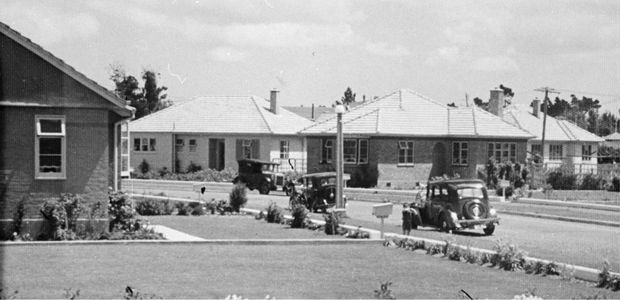Savage Crescent
Palmerston North’s Savage Crescent embraces English cottage style housing, art deco and even European designs but they’re all state houses dating from the late 1930s and early 40s. Researcher Margaret Tate shows Spectrum's Jack Perkins around Palmerston North’s Savage Crescent state housing precinct and they also meet long-time residents.

Researcher Margaret Tate at the entrance to Savage Crescent.
Savage Crescent is a notable early example of the massive housing programme brought in by the first Labour government when it swept to power in 1935.State housing changed the face of almost every city and town in New Zealand.

Same house,1940s and today.
Savage Crescent dates from 1937 and was designed as a 'garden suburb' with curved streets, and a central common reserve. It was the first of its kind outside the 4 main centres and has changed little in over 70 years. Labour Prime Minister Michael Joseph Savage spoke of building ‘smiling homes’ good enough for cabinet ministers to live in. This came to pass when Trevor de Cleeene and Steve Maharey, both ministers in Labour governments, lived in Savage Crescent.

Resident since 1947 Jack Shortt, Jack's daughter Lesley Cranfield, Evelyn Schou, Garry Cranfield and Jack's nephew Tony Evans.
The ‘garden suburb’ concept of housing planning had its genesis in 19 century Britain and was given impetus in New Zealand by Prime Minister Richard Seddon’s 1905 Workers’ Dwelling Act and by on-going severe housing shortages. The 245 houses in Savage Crescent were carefully positioned to maximize sun and were solidly built of quality materials, sourced in New Zealand if possible. All were equipped with sun rooms, flush toilets, gas cookers and fitted cupboards.

Streetscape early 1940s.